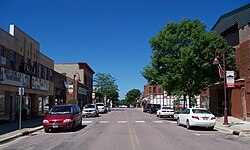Redwood Falls
| Redwood Falls, Minnesota | |
|---|---|
| City | |

Street in downtown Redwood Falls
|
|
| Motto: The town of redwood trees | |
 Location of Redwood Falls within Redwood County and state of Minnesota |
|
| Coordinates: 44°32′36″N 95°6′33″W / 44.54333°N 95.10917°W | |
| Country | United States |
| State | Minnesota |
| Counties | Redwood |
| Area | |
| • Total | 5.38 sq mi (13.93 km2) |
| • Land | 5.25 sq mi (13.60 km2) |
| • Water | 0.13 sq mi (0.34 km2) |
| Elevation | 1,040 ft (317 m) |
| Population (2010) | |
| • Total | 5,254 |
| • Estimate (2016) | 5,015 |
| • Density | 980/sq mi (380/km2) |
| Time zone | Central (CST) (UTC-6) |
| • Summer (DST) | CDT (UTC-5) |
| ZIP code | 56283 |
| Area code(s) | 507 |
| FIPS code | 27-53656 |
| GNIS feature ID | 0649900 |
| Website | www.ci.redwood-falls.mn.us |
Redwood Falls is a city in Redwood County, located along the Redwood River near its confluence with the Minnesota River, in the U.S. state of Minnesota. The population was 5,254 at the 2010 census. It is the county seat.
As the immigrant and Euro-American population of the North American east coast region grew, population pressures affected people far inland. People moved west to find new homes as more and more land was used by farmers. The Minnesota area is the ancestral homeland of the several Dakota peoples, who consisted of the loosely confederated Oceti sakowin (Seven Council Fires). By 1700, Ojibwe, who spoke an Anishinaabe language, had also come to what is now Minnesota from further east around the Great Lakes. At times they came into conflict with the Dakota over land and resources, and began to push them to the west.
By the mid-19th century, the traditional Dakota yearly cycle of farming, hunting, fishing, and gathering wild rice had been disrupted by cultural changes. Permanent farms were established by European-American settlers, changing habitat. In addition, they removed forests in eastern Minnesota for timber and to develop farmland. Wild game such as bison, elk, whitetail deer, and bear had been hunted so intensively that populations were much reduced compared to the centuries before Euro-American settlement. Dakota people relied on the sale of valuable furs to American traders to earn cash needed to buy necessities.
To encourage the Dakota to bring in more furs, traders offered merchandise on credit. It is not clear that the Dakota well understood the concept of credit, but they grew to depend on trade goods for metal tools and other items.
Pressure from traders who wanted to be paid and concern from government officials about the ability of the Dakota to earn the money they needed, led to the 1851 Treaty of Traverse des Sioux. The federal government wanted to extinguish Native American land title to tracts of land, and offered the people annuities of money and goods in exchange. The Dakota agreed to live on a twenty-mile-wide reservation centered on a 75-mile stretch of the upper Minnesota River. Annuity payments for the Dakota were late in the summer of 1862, an example of a pattern of poor delivery of payments and supplies to them.
...
Wikipedia
